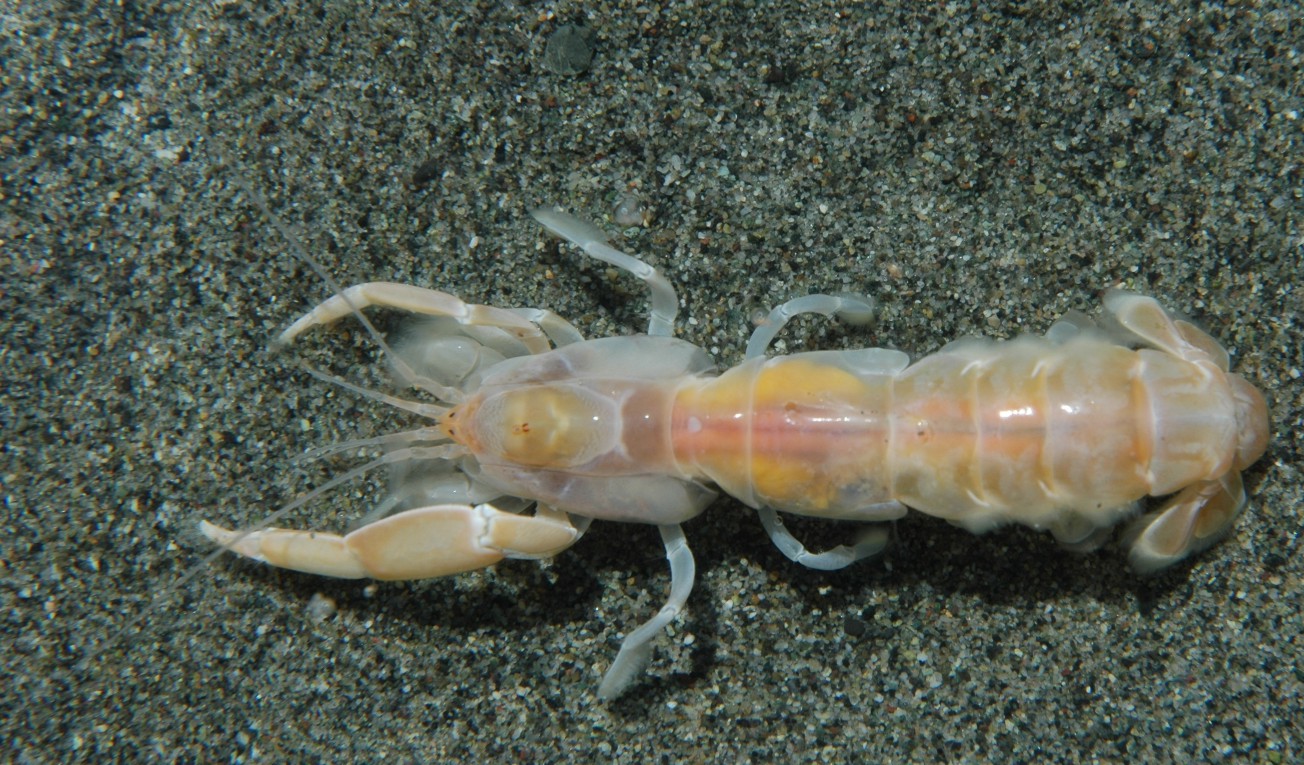How to Distinguish from Similar Species: N. gigas has a sharp rostrum, the large cheliped has no gap between the propodus and dactyl, and the carpus of the smaller cheliped is not much wider than the merus. N. affinis has rounded tips on the eyestalks and lives in California. Upogebia pugettensis has a broad rostrum that is hairy dorsally and divided into 3 teeth; its chelipeds are subchelate and of nearly equal size.
Geographical Range: Southern Alaska to Baja California
Depth Range: Intertidal, especially middle intertidal
Habitat: Intertidal in muddy sand. In areas of compact mud the burrow entrances may appear as small "volcanoes" on the surface
Biology/Natural History: Ghost shrimp make extensive, branching burrows in sand, burrowing down to 0.75 m depth. The burrows generally have more than one entrance, and the animal can often be found near the entrance pumping water into the burrow by beating their large pleopods during low oxygen conditions. They can survive anoxia for nearly 6 days. They constantly maintain and remodel their burrows, resulting in major overturn of sediments in areas where they are abundant similar to that accomplished by earthworms in terrestrial areas. They tolerate a wide range of salinities from on quarter seawater's salinity to substantially saltier than the ocean, though they are not as tolerant of low salinity as is Upogebia. They feed on detritus filtered from the water and sifted from the substrate by the hairs on their second and third legs. Breeding is year-round in California but egg-carrying females are most common in June and July. The larvae may remain planktonic for as long as 8 weeks. Likely because of this, individuals sampled from Washington all the way to California seem to be relatively homogeneous genetically. They may live as long as 16 years.
Predators include fish such as staghorn sculpin, and green sturgeon in estuaries such as Willipa Bay (Borin et al., 2017). Commensals in the burrow include the polychaete scaleworm Hesperonoe complanata, the snapping shrimps Betaeus harrimani and B. ensenadensis, and the pea crabs Scleroplax granulata, Pinnixa franciscana, and P. schmitti, the burrowing clam Cryptomya californica, and the goby Clevelandia sp. Commensals on the animal include the copepods Clausidium vancouverense and Hemicyclops thysanotus on the gills, as well as the parasitic isopod Ione cornuta.
The burrows of Neotrypaea californiensis can be distinguished from those of Upogebia pugettensis by the following characteristics (Chapman and Carter, 2014): Neotrypaea burrows have multiple connected openings, are not constricted at the entrance, and have rough linings to the walls. Upogebia burrows, on the other hand, typically have paired, connected entrances which are constricted at the entrance, and the burrow walls are quite smooth. In addition, in my experience Neotrypaea burrows are more common in sandy/gravelly areas, while Upogebia burrows are more common in finer sediment.
According
to work done by John Durban, Holly Fearnbach, and John Calambokidis and
reported by the Seattle Times and the Feb. 17, 2021 Walla Walla
Union-Bulletin, , a group of about a dozen gray whales nicknamed "The
Sounders" appears to have developed a new feeding strategy: On their
spring northward migration from the Baja California calving lagoons
they enter Puget Sound and swim to the mouth of the Skokomish river
near Everett, whic is about a 170-mile detour from their open coastal
route. There they wait for high tide, then swim across the shallow mud
flat area scooping up sediment in their baleen and separating out the
ghost shrimp to eat. Within three weeks they can be observed to plump
up noticeably. They swim up to a mile into the mud flats feeding in
water only 7 to 9 feet deep, which could quickly become hazardous for
them as soon as the tide begins to go out. The feeding pits they
produce are about 6 feet long and 2 feet wide. The group of whales is a
fairly cohesive one, with several members returning since the early
1990's although new whales have been sighted as well.
| Return to: | |||
| Main Page | Alphabetic Index | Systematic Index | Glossary |
References:
Dichotomous Keys:Carlton, 2007
Flora and Fairbanks, 1966
Hart, 1982
Kozloff 1987, 1996
Smith and Carlton, 1975
Wicksten, 2009
General References:
Harbo,
1999
Jensen,
1995
Johnson
and Snook, 1955
Kozloff,
1993
Morris
et al., 1980
Niesen,
1994
Niesen,
1997
Ricketts
et al., 1985
Sept,
1999
Scientific Articles:
Borin, J.M., M.L. Moser, A.G. Hansen, D.A. Beauchamp, S.C. Corbett, B.R. Dumbauld, C. Pruite, J.L. Ruesink, and C. Donoghue, 2017. Energetic requirements of green sturgeon (Acipenser medirostris) feeding on burrowing shrimp (Neotrypaea californiensis) in estuaries: importance of temperature, reproductive investment, and residence time. Environ. Biol. Fish. (2017): 1-13. DOI: 10.1007/s10641-017-0665-3
Chapman, John W., and Cameron S. Carter, 2014. A rapid intertidal megafauna survey method applied to Upogebia pugettensis, and its introduced parasite, Orthione griffensis. Journal of Crustacean Biology 34:3 pp 349-356
Dumbauld, B.R., D. A. Armstrong, and K. L. Feldman, 1996. Life-history characteristics of two sympatric thalassinidean shrimps, Neotrypaea californiensis and Upogebia pugettensis, with implications for oyster culture. Journal of Crustacean Biology 16:4 689-708Dumbauld, B.R., and S. Wylie-Echeverria, 2003. The influence of burrowing thalassinid shrimps on the distribution of intertidal seagrasses in Willapa Bay, Washington, USA. Aquatic Botany 77: 27-42
Pernet, Bruno, Aimee Deconinck, and Lisa Haney, 2010. Molecular and morphological markers for distinguishing the sympatric intertidal ghost shrimp Neotrypaea californiensis and N. gigas in the eastern Pacific. Journal of Crustacean Biology 30:2 323-331
Pernet, B., A. Deconinck,
A. Llaban, and J. Archie, 2008. Evaluating risks associated
with transport of the ghost shrimp Neotrypaea
californiensis as live bait. Marine Biology 153:
1127-1140
Posey, M. H., 1986. Changes in a benthic community associated
with dense beds of a burrowing deposit feeder, Callianassa
californiensis.
Marine Ecology Progress Series 31: 15-22
Web sites:
Newspaper
article: Mapes, Lynda V., 2021 (Seattle Times). Gray whales learn
feedng strategy in Puget Sound: Digging for shrimp at high tide.
Article on page A2 of the Walla Walla Union Bulletin, February 17, 2021.
General Notes and Observations: Locations, abundances, unusual behaviors:
I have not found these in Padilla Bay, though they can be
found in the
sandier muds of Useless Bay and Holmes Harbor.
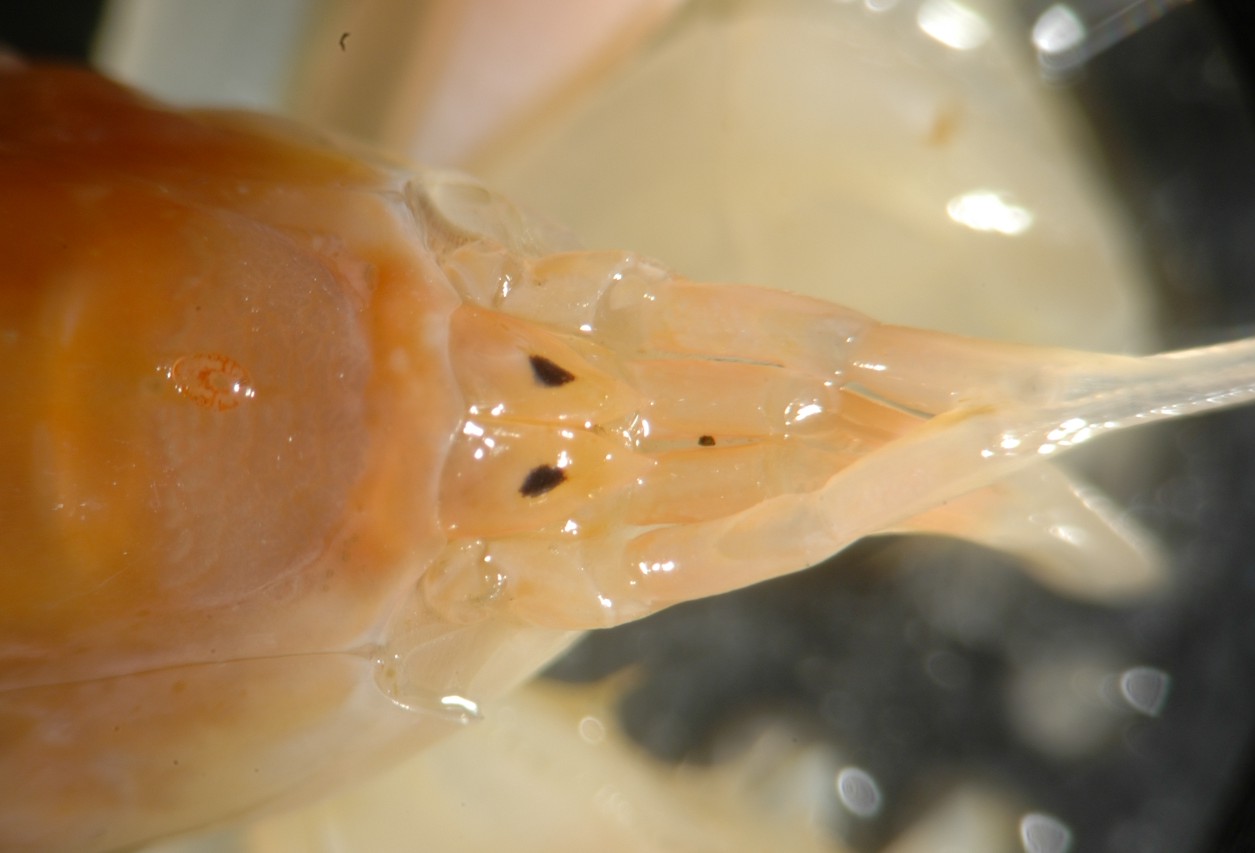
The rostrum
is a broad and bluntly rounded tooth. The eyestalks are
flattened,
and the eyes (cornea) appear as dark patches mid-dorsally on the
eyestalk
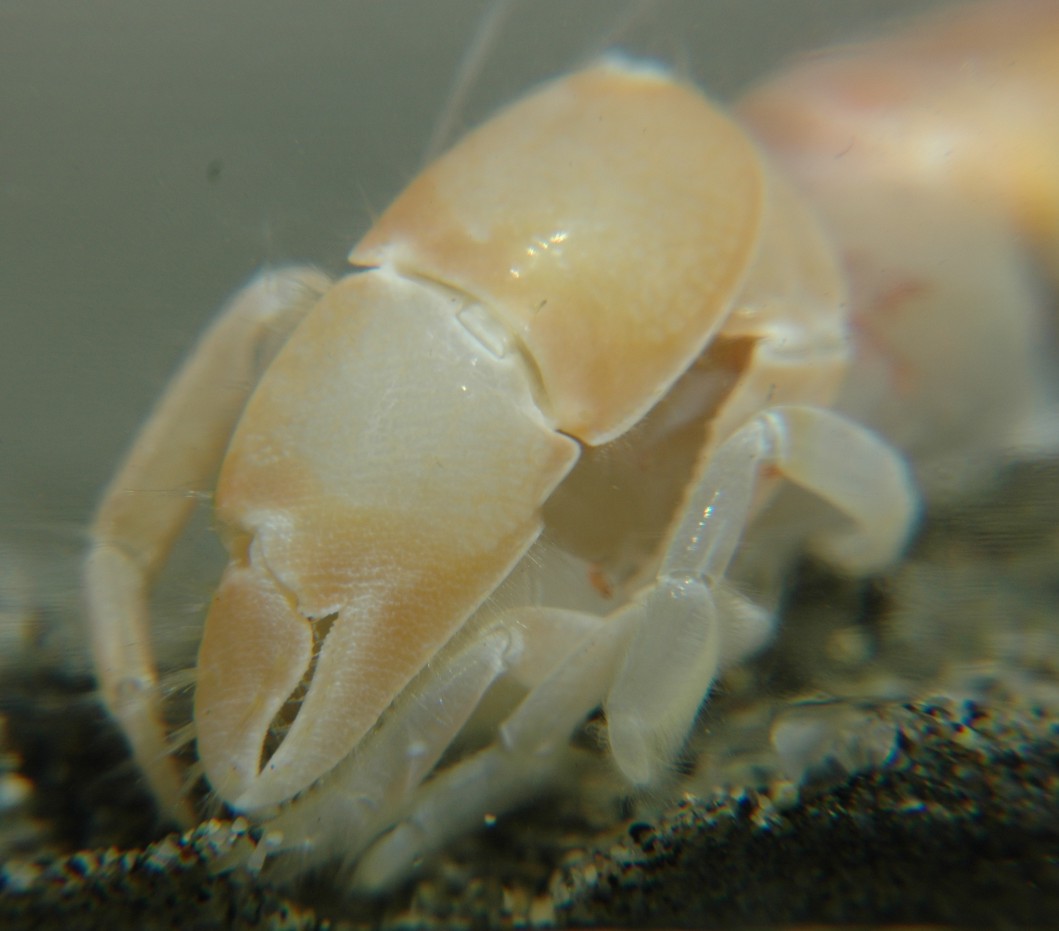
There is a gap between the propodus
and dactyl
on the large chela.
In this case the large chela
is the left one but it may be the left or the right.
The hairs on the legs are used for sifting food from the substrate.
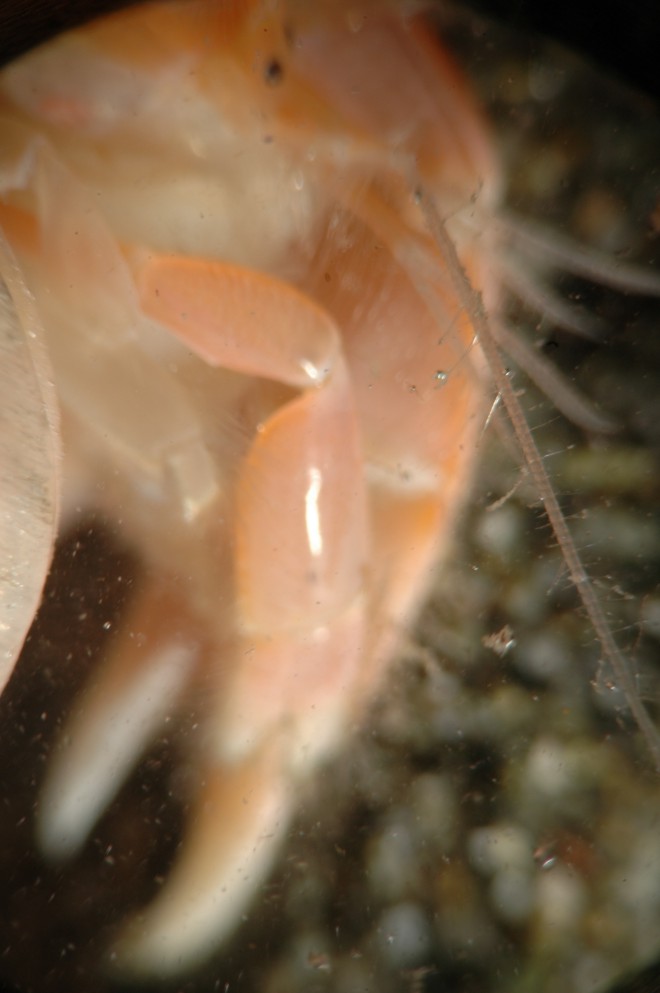
In this view one can see that the carpus
of the small cheliped
(foreground) is wider than is the merus.
The propodus
and dactyl
are below and slightly out of focus; and the large chela
is in the background.
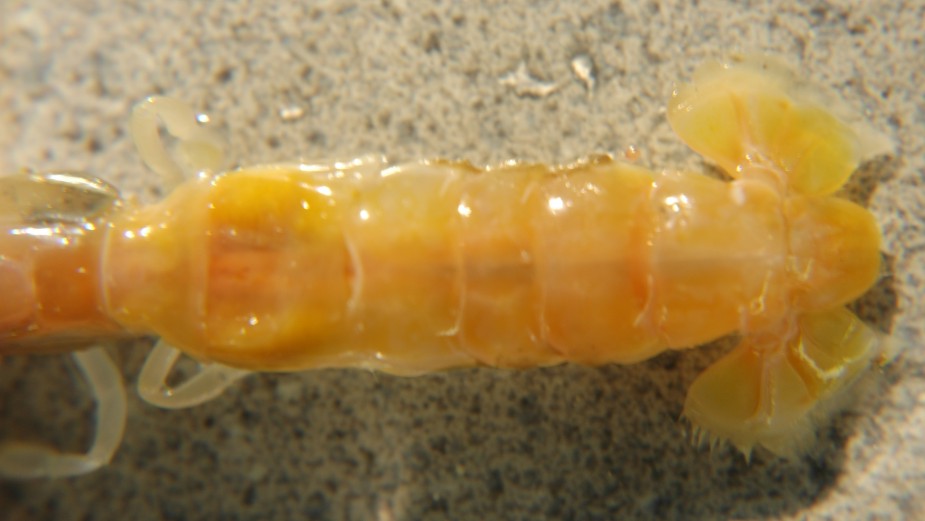
As a Thalassinidean, Neotrypaea
californiensis has a broad abdomen and a well-developed
tailfan.
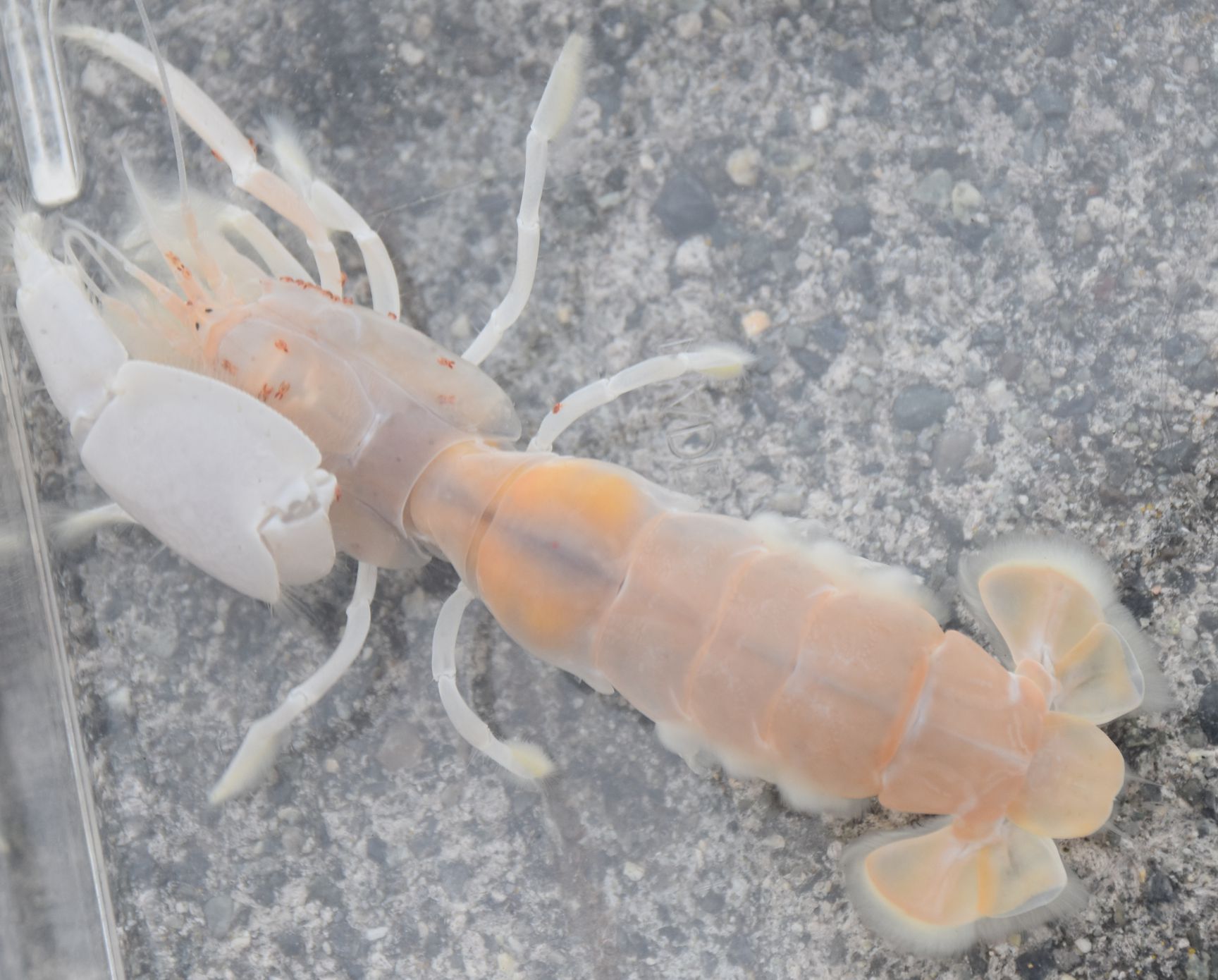
This
8 cm individual, collected from the beach at Freeland, has many
individuals of the red parasitic Poecilostomatoid copepod Clausidium vancouverense running around in its gill chamber. Photo by Dave Cowles, July 2020.
Authors and Editors of Page:
Dave Cowles (2007): Created original page
CSS coding for page developed by Jonathan Cowles (2007)
